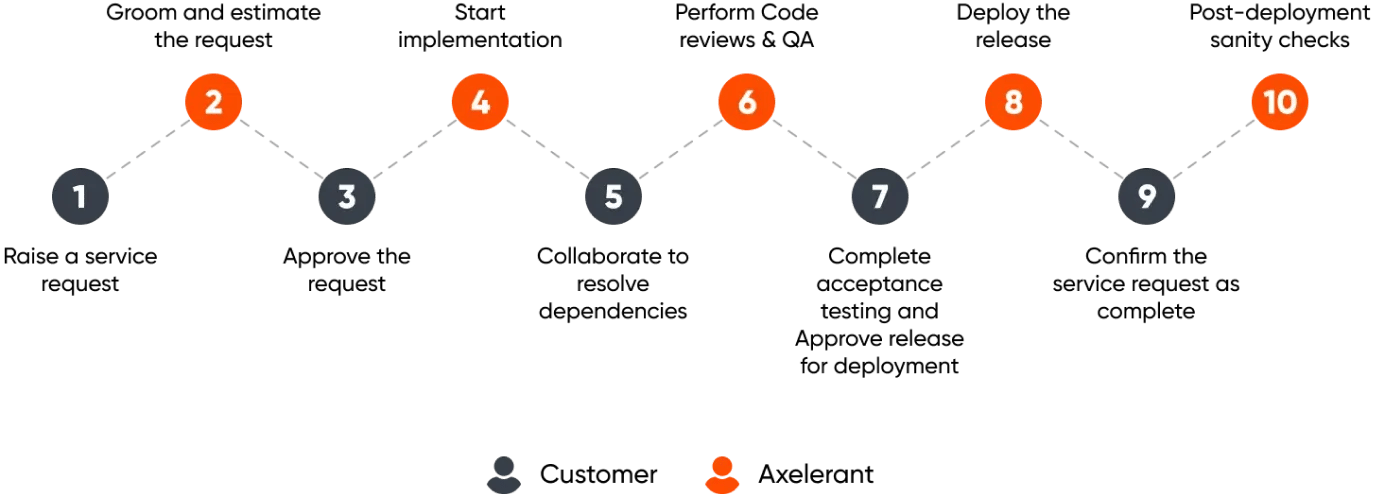Introduction
Trust building with customers is a journey. Particularly when a customer has had unpleasant experiences in the past or their business priorities are fast changing, they are reluctant to adopt an all-in approach when evaluating and contracting with a new agency. Such times require an adaptive and outcome-oriented approach to bringing the customer onboard. It tends to create challenges in team planning and meeting service level agreements on the agency’s side, too.
Some projects demand a flexible approach. Customers with evolving priorities often bring open-ended requirements, a reluctance to commit to contracts, and a need for measurable outcomes. These challenges are compounded when technical debt, left behind by previous vendors, slows even the simplest updates and creates inefficiencies.
One of our clients consistently required urgent help on high-priority issues, but there was no formal agreement to address such unplanned tasks. This pattern of recurring urgent requests creates challenges in maintaining a balanced workload, as the team had to repeatedly divert resources from planned deliverables to handle last-minute priorities.
- Ulka Neil, Associate Project Manager, Axelerant
A structured engagement model like Continuous Development and Maintenance (CDM) could resolve these issues. Yet when ROI and a value-based approach are used as yardsticks to determine procurement, agencies need to come up with a flexible approach - one that balances flexibility with operational discipline to deliver results effectively.
This blog explores how a Flexible Delivery Model combines CDM principles with tailored solutions to address open-ended needs, resolve technical inefficiencies, and align with outcome-driven expectations.
The Challenge: Managing Unplanned Client Requests
Unplanned client requests are not uncommon in project delivery. According to a survey by the Project Management Institute (PMI), over 35% of projects face scope creep due to poorly defined agreements or sudden changes in client priorities.
These unplanned tasks often result in:
- Resource Strain: Teams are forced to redirect focus from planned deliverables to address unplanned tasks, affecting productivity and morale.
- Scope Ambiguity: Without a clear framework, it becomes difficult to define boundaries, leading to misaligned expectations.
- Risk To Trust: Failing to address urgent client needs can harm relationships, while overcommitting without a framework can lead to burnout and missed deadlines.
We were operating without a formal support contract, which meant any unplanned priority issues had the potential to derail ongoing work. It was critical to address this head-on, not just operationally but strategically.
- - Ulka Neil, Associate Project Manager, Axelerant
While Axelerant’s CDM (Continuous Development and Maintenance) model provides ongoing support, the client needed more flexibility with outcome-based pricing—defined tasks rather than pre-purchased hours—and a task-specific focus with clear deliverables and defined timelines.
To meet these requirements, the team created a Flexible Delivery Model that retained CDM’s core principles while adapting to deliverable-driven execution and predictable results.

The Solution: Crafting A Flexible Delivery Model
To address these challenges, the team developed a custom and flexible delivery model that preserved the responsiveness the client valued while ensuring sustainability and alignment with delivery objectives. This approach borrowed key principles from CDM but tailored them to suit the client’s specific needs.
Here’s how the team crafted a flexible delivery model to navigate unplanned requests while ensuring long-term alignment.
1. Defining The Core Objectives
The primary goal of the custom model was to address the client’s concerns while maintaining delivery integrity. This required:
- Retaining flexibility for ad-hoc urgent requests.
- Avoiding the perception of a rigid, high-overhead framework.
- Providing transparency to demonstrate the value of structured resource allocation.
The focus was on designing a model that met their expectations for flexibility without compromising our ability to deliver efficiently,
- Ulka explained.
2. Adapting CDM Principles For Flexibility
Recognizing the need for flexibility, the team proposed a tailored delivery model that balanced responsiveness with scalability, built on the foundation of CDM principles:
- Task Categorization: Urgent, planned, and enhancement tasks were dynamically categorized to prioritize what mattered most.
- Scope Flexibility: Allowing for unplanned requests while setting clear boundaries to protect the project’s integrity.
- Dedicated Resource Pool: A segment of the team’s capacity was reserved for recurring unplanned requests, enabling the team to maintain responsiveness without disrupting planned work.
- Agile Workflows: Automation tools streamlined task integration into sprints, ensuring the flexibility the client desired.
|
Strategic Resource Allocation and Forecasting at Axelerant Additionally, incorporating Workforce Management practices helped streamline processes to accommodate urgent tasks while ensuring planned deliverables stayed on track. These practices emphasized balancing current capacity with new demands through dynamic team restructuring |
3. Transparent Communication And Governance
To address the client’s concerns around rigidity, the team established a collaborative governance framework:
- Priority Check-Ins: Regular touchpoints allowed the client to influence task prioritization, reinforcing their sense of control over the workflow.
- Clear Deliverable Transparency: The team outlined the scope and timeline for every task to mitigate concerns about delays within a structured model.
We wanted to assure the client that flexibility and transparency were at the core of the custom model, even if it followed structured principles,
- Ulka noted
4. Proactive Resource Forecasting
Leveraging Axelerant’s Workforce Management and Capacity Planning frameworks, the team ensured resources were dynamically allocated to meet recurring urgent needs without straining bandwidth. This addressed the client’s cost concerns by showing how resources were efficiently utilized.
 Outcomes: Addressing The Client’s Reluctance While Ensuring Delivery
Outcomes: Addressing The Client’s Reluctance While Ensuring Delivery
The custom delivery model successfully resolved the client’s concerns while achieving key delivery outcomes:
- Responsiveness Maintained: Urgent requests were handled promptly through the dedicated resource pool and agile workflows.
- Transparency Built Trust: The governance framework reassured the client that their priorities were consistently addressed.
- Sustainability Achieved: Proactive planning minimized disruptions to planned deliverables and prevented burnout.
By addressing the reasons for the client’s reluctance, the team demonstrated how flexibility and structure could coexist, strengthening trust and collaboration.
I just know that if something comes up I can immediately connect with Marilyn and she will make sure that our needs are met and Doctor Without Borders needs are met as quickly as possible so it's been a pleasure.”
- Rachel Sevcik, Project Manager, Blue State
Conclusion: Flexibility As A Strategic Advantage
While Axelerant’s CDM engagement model is the gold standard for addressing recurring unplanned requests, this experience demonstrates that flexibility is key when clients are hesitant to adopt formal frameworks. By adapting CDM principles into a custom delivery model, the team was able to balance agility with sustainability, meeting immediate needs while paving the way for long-term collaboration.
Flexibility isn’t just about reacting to change, it’s about designing thoughtful solutions that align with both client expectations and delivery goals.

Ulka Neil, Associate Project Manager
Nature lover. Poetry admirer. Kathak learner. Ulka brings a deep sense of reflection and calm to everything she does, balancing her inner world with a steady focus on learning and growth.

 We respect your privacy. Your information is safe.
We respect your privacy. Your information is safe.
Leave us a comment